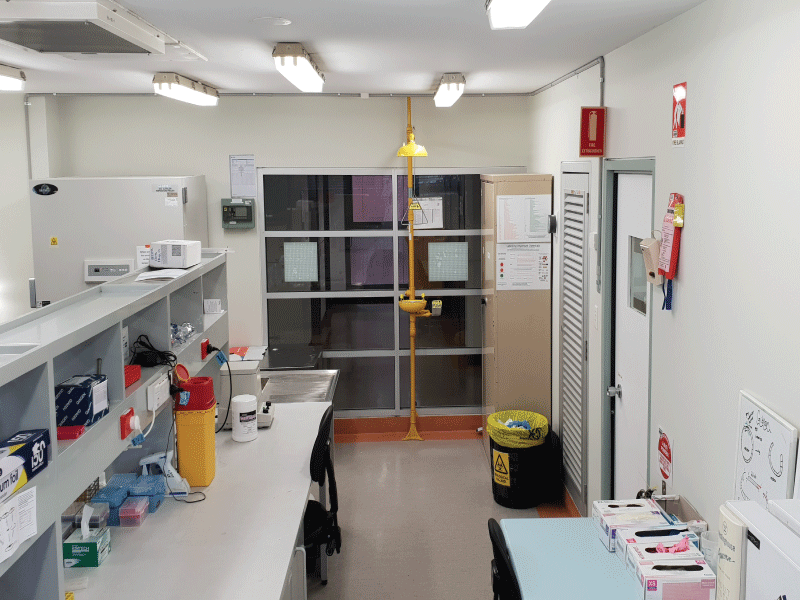

Safety
Safe Working Practices
General
Before any lab work started, our team members were inducted into the lab, ensuring everyone knows where the lab's safety features are, such as the eyewash and safety shower, fire blanket, fire extinguisher and spill cleanup kit. Team members were also trained on equipment and read the relevant Safe Work Procedure (SWP) and Risk Management Form (RMF) before using it. This simple act of training our team members before starting work was arguably the greatest reduction in risk as it means we could conduct ourselves in a safe way, having knowledge of the risks involved in all procedures we conducted. Our use of Personal Protective Equipment (PPE) such as a lab coat, safety goggles, gloves (when appropriate), long pants, leather-topped shoes and hair tied back was also a great advantage in risk reduction, and of course, we never forgot to wash our hands before leaving the lab!
Our environment conscious lab team was also trained in the proper disposal of chemical waste, separating it from our general bio-waste in a separate waste cube and autoclaving or chemically disinfecting our biological waste before disposal. Our flammables and corrosives were kept in their own respective storage cabinets and everything in the lab was fully labelled, making sure all associated hazards were highlighted where relevant. We were also trained on what to do in the case of a spill, including the use of the spill kit.
Salkowski Assay
The Salkowski assay is the method of choice for quantifying indole-3-acetic acid production, one of the pathways chosen to test our scaffold. This method involves the use of a strong acid, and hence a team dedicated to the assay was thoroughly trained in the risks involved and how to minimise them, including what to do in the case of a spill.
OGTR
To ensure the highest level of safety for our team, we followed the guidelines set out by the OGTR.


Figure 1: View of our lab. Note the safety shower and eye wash station, fire extinguisher, fire blanket, gloves, cavicide wipes, sharps and biological waste disposal bins.

Figure 2: View of our lab. Note the biological safety cabinet, flammables storage, chemical waste storage and broken glass container.

Figure 3: Chemical and biological waste disposal cubes, broken glass bin and the clean up kit, kept at the centre of the lab for easy access.

Figure 4: Lab member using the biosafety cabinet to protect both us and our work.

Figure 5: Lab member using the biosafety cabinet to protect both us and our work.

Figure 6: Hands free wash station to ensure nothing we work with escapes the laboratory.

Figure 7: The safety gear we wear as modelled by one of our fabulous team members <3

Safe Project Design
The two organisms our team used throughout the year were NEB DH5α and NEB T7 Express, both competent Escherichia coli (E. coli) strains derived from BL21 and E. coli K-12 respectively1. We chose these strains to work with as they suited our needs, allowing us to produce sufficient plasmid DNA in DH5α and proteins in T7 Express. Further, these strains come with the extra benefit of posing a minimal risk to both our team and the environment. The two NEB E. coli strains are classified as not hazardous according to the Globally Harmonized System (GHS) as they are not known to consistently cause disease in immunocompetent adults. Moreover, DH5α does not mutate or pass on DNA that it hosts and has been engineered to lack the ability to produce thiamine and leucine, making it unable to survive in the environment without these two compounds supplemented.
Prefoldin was the main part our team used, forming the backbone of our scaffold. The protein is from an archaea strain, Methanothermobacter thermautotrophicus Delta H, chosen due to its thermal and chemical stability as a chaperone. The two enzymes IaaH and IaaM originate from Alcaligenes faecalis 16 and Pseudomonas savastanoi 2076-31/2 respectively. All three of these organisms are classified as risk group 1 by DSMZ2 and pose minimal to no hazard to our team members or the environment, and even less considering the use of only one protein from the organism. The final two parts we worked with were mCerulean3 and mVenus, two variants on green fluorescent protein, deemed to have no risk group by the iGEM safety page due to their low hazard potential. In choosing these parts, we are able to assess the modularity of the scaffold, showing an increase in efficiency of transfer between enzymes with IaaH and IaaM, as well as measuring the distance between the monomers of the scaffold with FRET and the fluorescent proteins.
More information on the parts we used and created can be found here.
Safety in Shipping/Transport
We did not face any problems in sending our DNA parts to the Registry. We sealed our parcel and filled out the required customs declaration for shipment.

Figure 8: UNSW iGEM's parts being mailed to Boston.
Safety Documentation
Safety Form
Here you can find our official iGEM safety form.
SWPs and RMFs
All of our Safe Working Practices and Risk Management Forms can be found linked in the table below
References
- Daegelen, P. et al. Tracing ancestors and relatives of Escherichia coli B, and the derivation of B strains REL606 and BL21(DE3). J Mol Biol. 394 634-643, doi:10.1016/j.jmb.2009.09.022 (2009).
- DSMZ, Catalogue of Microorganisms. Dsmz.de (2018). at <https://www.dsmz.de/catalogues/catalogue-microorganisms.html>

